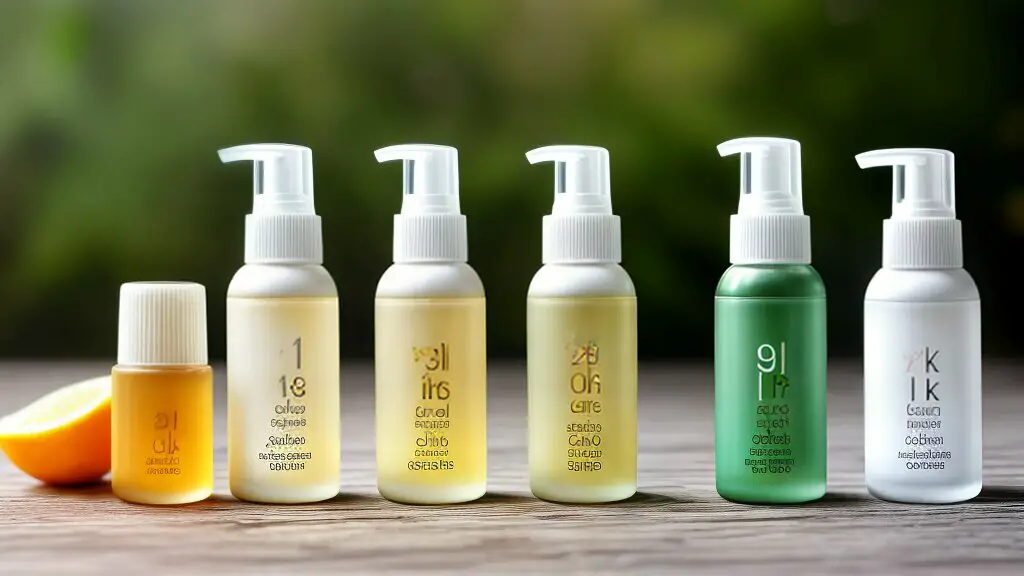How to Use Vitamin C Serum, Hyaluronic Acid, and Retinol | Skin Care Guide
Are you looking to enhance your skincare routine? Incorporating vitamin C, hyaluronic acid, and retinol serums can do wonders for your complexion. These powerful ingredients are known for their ability to brighten, hydrate, and rejuvenate the skin.
This guide will help you to explore the benefits of using each serum and provide step-by-step instructions on incorporating them into your daily routine. Whether you are a skincare novice or a seasoned pro, discover how these serums can transform your skin.
Key Takeaways:
- Vitamin C, hyaluronic acid, and retinol serums can enhance your skincare routine.
- Each serum offers unique benefits, including brightening, hydration, and anti-aging properties.
- Following our step-by-step instructions, you can effectively use these serums to achieve healthier, younger-looking skin.
Benefits of Vitamin C Serum
Vitamin C serum is a powerful form of antioxidant that can provide various benefits for the skin. Here are some of the key benefits of including vitamin C serum into your skincare routine:
| Benefit | Description |
|---|---|
| Brightens complexion | Vitamin C can help brighten skin tone and hyperpigmentation and also reduces the appearance of dark spots |
| Promotes collagen production | Vitamin C is crucial for collagen synthesis, which can helps to improve the elasticity of the skin and also help to reduce the look of fine lines and wrinkles. |
| Protects against environmental damage | Vitamin C acts as a powerful antioxidant, that helps in neutralizing free radicals present in the environment which can cause severe damage to the skin. |
Overall, vitamin C serum can be an effective tool for achieving brighter, healthier-looking skin
How to Use Vitamin C Serum
Vitamin C serum is a popular addition to many skincare routines due to its ability to brighten the complexion, promote collagen production and reduce the appearance of dark spots. If you’re looking to incorporate vitamin C serum into your daily routine, follow these steps for the best results:
- Start cleansing and drying your face, as you would for any skincare routine.
- Take a tiny amount of the vitamin C serum to your fingertips, gently tapping to apply it fairly to your face, avoiding the eye area.
- Allow the serum to absorb fully before following up with a moisturizer and sunscreen if used in the morning. Vitamin C might make your skin to be more sensitive to the sun, so protecting your skin is essential.
- For the best results, use the vitamin C serum in the morning and follow up with a hyaluronic acid serum and retinol serum in the evening.
- Be patient and consistent with your use of vitamin C serum. It can take up to six weeks to see results, so it’s essential to use it everyday and incorporate it into your daily routine.
Remember that vitamin C serum can be a powerful addition to your skincare routine, but it’s essential to follow the given instructions carefully and follow it consistently for the best results.
Benefits of The Hyaluronic Acid
The Hyaluronic acid is a acid that is naturally occurring in the body which plays a vital role in keeping the skin firm supple and hydrated. However, as we age, the production of this hyaluronic acid decreases, leading to dry, dull, and sagging skin. The hyaluronic acid serum is a widely known skincare product that helps replenish the skin’s natural supply of hyaluronic acid, providing numerous benefits for youthful-looking skin.
| Benefit | Description |
|---|---|
| Hydration | Hyaluronic acid has the unique capacity to pull and retain moisture, helping to keep the skin plump and hydrated. This will lead to a more youthful appearance, as dehydrated skin can emphasize fine lines and wrinkles. |
| Plumping | By hydrating the skin, hyaluronic acid can also help to plump it up, reducing the appearance of fine lines and wrinkles. This effect can instantly boost radiance and glow to the skin. |
| Improved Skin Texture | Hyaluronic acid can also help improve the skin’s overall texture, making it smoother and more supple. This can be particularly helpful for those with dry or rough skin. |
The hyaluronic acid serum is perfectly suitable for all skin types, including sensitive skin. This serum can be used side by side with other skincare products just like vitamin C serum and retinol serum, for maximum benefits.
How to Use Hyaluronic Acid
The Hyaluronic acid serum is a widely known skincare product which can help hydrate and plump the skin. Here are some tips on how to use the hyaluronic acid serum onto your skincare routine:
- Clean your face: Start by cleansing your face to remove any dirt or makeup present on the skin.
- Apply hyaluronic acid serum: Take a small amount of hyaluronic acid serum and apply it to your face, neck, and decolletage. Gently rub the serum into your skin using circular motions.
- Follow up with moisturizer: After applying hyaluronic acid serum, afterwards follow up with a moisturizer to lock in the hydration. This will maximize the benefits of the serum and leave your skin feeling soft and supple.
- Use it morning and night: Hyaluronic acid serum can be used twice a day, in the morning and at night, to maintain optimal hydration levels in the skin. For best results, apply it into damp skin to maximize absorption.
When using hyaluronic acid serum, it’s essential to keep in mind that it can be used in combination with other skincare products. For example, you can layer it with vitamin C or retinol serum for added benefits. However, paying attention to the order in which you apply the products to ensure they work together effectively is essential.
Benefits of Retinol Serum
Retinol serum has become a widely known ingredient when it comes to skincare due to its numerous benefits for the skin.
- Improves skin texture: Retinol can improve the skin’s overall texture by increasing collagen production, which reduces the appearance of fine lines and wrinkles.
- Reduces hyperpigmentation: Retinol can help lessen the look of dark spots and other forms of hyperpigmentation by accelerating skin cell turnover.
- Promotes cell turnover: Retinol increases the rate at which skin cells turnover, helping to create a smoother, healthier-looking complexion.
- Reduces acne: Retinol can effectively reduce acne by unclogging pores and decreasing inflammation.
It is important to note that retinol is a powerful ingredient and can cause skin irritation if not used properly. It is recommended to start with a low concentration and gradually increase usage over time. Using sunscreen when using retinol is also important, as it might increase skin sensitivity to UV rays.
How to Use Retinol Serum
Retinol serum can be a powerful addition to any skincare routine, but it is crucial to use it correctly to avoid potential irritation or adverse side effects. Here are some tips for effectively incorporating retinol serum into your skincare regimen:
- Start slow: If you are new to retinol, start with a low concentration of Retinol and then gradually increase usage as your skin adjusts. Begin using it only once a week, then gradually increase to every other night, and eventually every night.
- Apply to clean, dry skin: Before applying retinol serum, cleanse and dry your face thoroughly. This will help the serum absorb more effectively into your skin.
- Use sunscreen: Retinol might make your skin more sensitive to the sun, so it is very important to use broad-spectrum sunscreen with atleast SPF of 30 or higher during the day.
- Be patient: It can take several weeks or even months to see significant results from retinol serum. Stick with it and be patient!
- Be aware of potential side effects: While retinol is an excellent option for achieving healthier skin, it can also cause irritation, dryness, or peeling. If you experience these side effects, try reducing your usage frequency or concentration.
Incorporating Vitamin C Serum, Hyaluronic Acid, and Retinol into Your Skincare Routine
When achieving optimal skin health, incorporating vitamin C serum, hyaluronic acid serum, and retinol serum into your skincare routine can make a notable difference. Here’s how to effectively combine these powerhouse ingredients.
Step 1: Start with Cleansed Skin
Before applying any serums, starting with a clean slate is important. Begin with a gentle cleanser that removes any dirt or oil without stripping the skin of its natural moisture.
Step 2: Apply Vitamin C Serum
After cleansing and drying your face:
- Apply vitamin C serum.
- Use a pea-sized amount and gently massage the serum onto both your face and neck, strictly staying away the eye area.
- Wait a few minutes for the serum to fully soak before moving on to the next step.
Step 3: Follow with Hyaluronic Acid Serum
Next, apply a small amount of hyaluronic acid serum to your face and neck while the skin is still slightly damp from the vitamin C serum. The hyaluronic acid will help retain moisture and plump the skin.
Step 4: Finish with Retinol Serum, if Desired
If you use retinol serum in your routine, apply it after the hyaluronic acid serum has been fully absorbed. Start with a low concentration of Retinol and then gradually increase usage, as retinol can cause skin irritation if not used correctly.
Step 5: Moisturize and Protect
Finally, apply a moisturizerwhich suits your skin type/ concern and contains sunscreen with atleast a minimum of SPF of 30 to protect your skin from UV damage.
You can achieve healthier, more youthful-looking skin by incorporating vitamin C serum, hyaluronic acid serum, and retinol serum into your daily skincare routine.
Conclusion
Incorporating vitamin C serum, hyaluronic acid serum, and retinol serum into your daily skincare routine can help promote healthier, younger-looking skin.
Vitamin C serum provides powerful antioxidants and will help to reduce the loots of dark spots and promote collagen production.
Hyaluronic acid serum can help attract and keep moisture into the skin, leading to a plumper, supple more youthful appearance.
Retinol serum can improve skin texture, reduce the appearance of wrinkles, and promote cell turnover.
When using these serums, following proper application techniques, frequency of use, and potential interactions with other skincare products is important. Start with a low concentration and gradually increasing usage can help avoid possible side effects.
Combining these serums in a step-by-step approach can maximize their effectiveness and achieve noticeable results. Always consult with a Dermatologist before incorporating new products into your skincare routine.

I’m Carol Edwards, the force behind SerumDeals.com – your one-stop for all things serum. With over a decade of obsessing over skincare, I’m here to demystify sensational skin. I dig deep, testing serums in action. Beyond the surface, I uncover actual effectiveness. From ingredient breakdowns to real-life testing, my reviews are your trustworthy guide. Whether you’re a skincare rookie or diving into specifics like anti-aging or hydration, I’ve got your back with accurate info. Let’s simplify the serum journey together. SerumDeals.com isn’t just a site; it’s a hub for thriving skincare aficionados. Join me to uncover vibrant skin, one serum at a time.
Glowingly, Carol Edwards






